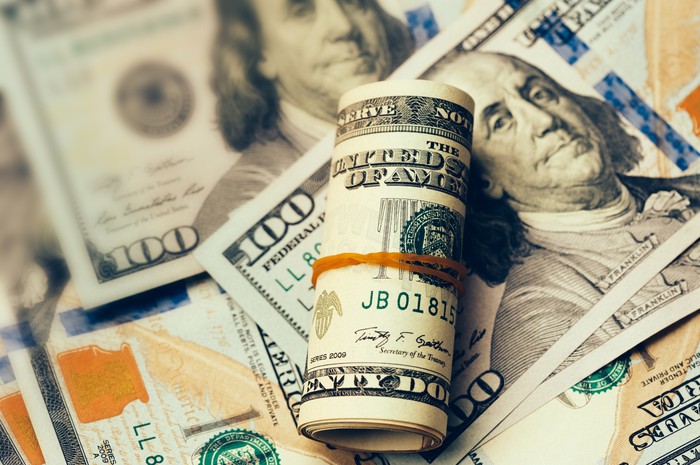
If you’re investing in individual stocks, the balance sheet should not be ignored. It’s a good idea to avoid companies with excessive debt. It’s fine in reasonable doses, but too much makes a company fragile.
On the flip side, companies with huge piles of cash and little debt can make for great investments. Having ample cash lying around gives a company flexibility, allowing it to take advantage of opportunities that arise while weathering any storm that comes its way.
Footwear company Skechers (NYSE:SKX), wearables company Fitbit (NYSE:FIT), and semiconductor equipment manufacturer Kulicke & Soffa (NASDAQ:KLIC) each have impressive mountains of cash at their disposal. Here’s what you need to know about these cash-rich companies.
Skechers
This footwear company has been accumulating cash for years as it grew sales and increased profits. It has doubled its revenue over the past five years, and it’s more than doubled its net income. A healthy chunk of the cash flow generated during this time has gone straight to the balance sheet.
Skechers had cash, cash equivalents, and short-term investments of $927 million at the end of 2018, up from $736 million at the end of 2017. After backing out the small amount of debt Skechers carries, the company’s net cash totals roughly $877 million.
Skechers’ market capitalization is about $4.75 billion, so its net cash accounts for around 18.5% of the company’s value. While the stock trades for nearly 15 times the average analyst estimate for 2019 earnings, that price-to-earnings multiple falls to around 11 after the net cash is backed out.
For Skechers, having plenty of cash makes the company much less vulnerable to events outside of its control. The trade war between the U.S. and China and the general economic uncertainty around the world haven’t yet made much of a dent in Skechers’ results. That could change, though, especially given how important China is to Skechers’ international growth ambitions.
With a ton of cash on the books, Skechers has the flexibility it needs to invest in growth and the ability to work through periods of reduced demand. Add in a depressed valuation, and you have a stock worth buying.
Fitbit
Fitbit made it big selling millions of fitness trackers during its heyday. Revenue topped $2 billion in 2016, and operating income peaked at $340 million the year before. Margins were exceptional, and Fitbit became synonymous with the product category that it helped create.
But all good things eventually come to an end. Demand for fitness trackers plummeted, despite heavy spending on Fitbit’s part to come up with new products. The company more than doubled its research and development spending in 2016, but sales still began to slump in the following years. The company generated just $1.5 billion of revenue last year, and it posted an operating loss of nearly $200 million.
But thanks to its balance sheet, Fitbit can absorb losses as it pivots to smartwatches. It had cash, cash equivalents, and marketable securities of $723 million at the end of 2018. With no debt, the company’s cash accounts for just about half of its $1.45 billion market capitalization.
Despite successfully entering the smartwatch market with the affordable Fitbit Versa, the company expects to continue losing money this year. Fitbit expects its free cash flow to range from a loss of $40 million to a loss of $70 million in 2019, meaning that its cash pile will likely erode a bit. Even a slate of impressive new products, including inexpensive new fitness trackers and a pared-down version of the Versa, won’t be enough to turn the bottom line black.
But Fitbit’s hoard of cash buys it time to execute its smartwatch-driven turnaround. The market is valuing the actual business at barely more than $700 million, less than half its annual revenue. I don’t own Fitbit stock, but I’m keeping an eye on it. It looks like a bargain turnaround play with plenty of upside if the company can return to sustainable profitability.
Kulicke & Soffa
The semiconductor industry is cyclical, and so is the semiconductor equipment industry that serves it. Kulicke & Soffa, a manufacturer of semiconductor packaging equipment, is currently going through a downturn, with revenue slumping and earnings falling off a cliff. But that’s completely normal.
It’s especially important for companies prone to cyclical demand to maintain a solid balance sheet. There’s no telling how long any given downturn will last, or how deep it will be. The company sees the current downturn as a short-term phenomenon, but no one really knows how long it will last. Predicting the timing of cycles in the semiconductor industry is more guesswork than anything else.
Kulicke & Soffa suffered a 26% year-over-year decline in revenue in the first quarter, and it saw its adjusted EPS plummet by more than 50%. The pain will continue into the second quarter, with the company expecting an even steeper revenue decline. But this isn’t Kulicke & Soffa’s first rodeo. Revenue and profit have been subjected to big swings over the past decade. The company lost money in only one year of the past 10: 2009.
A cash-rich balance sheet is an asset when things turn ugly. Kulicke & Soffa had $632 million of cash, cash equivalents, and short-term investments at the end of the first quarter, and just $15 million in financing obligations. That net cash accounts for more than 40% of the company’s $1.46 billion market capitalization.
Even if this downturn is more severe than the company expects, Kulicke & Soffa won’t have any trouble coming out the other side thanks to its mountain of cash.
